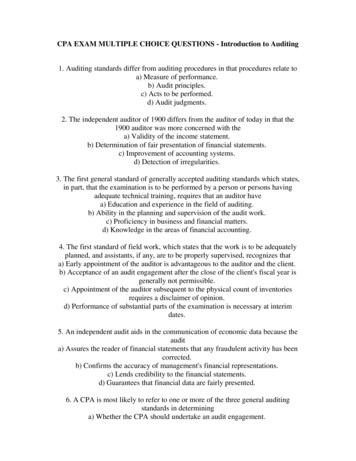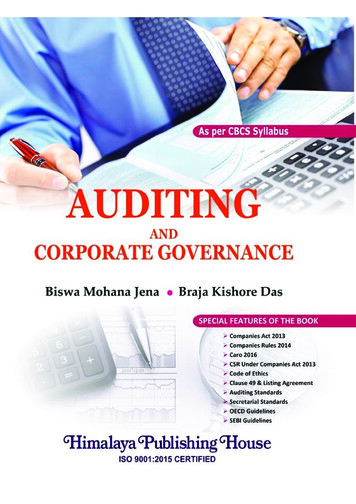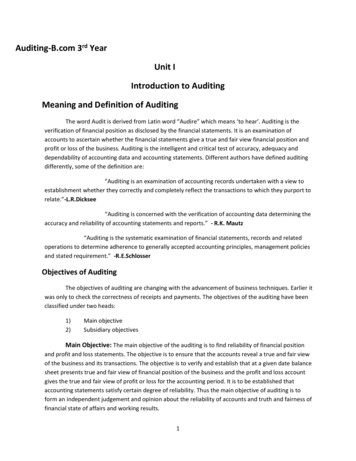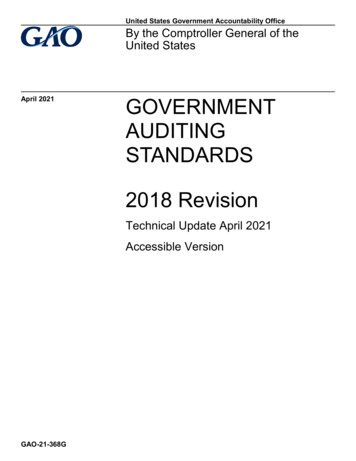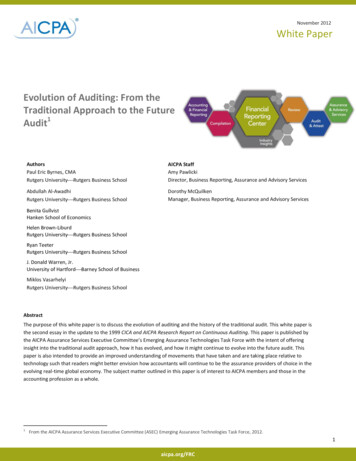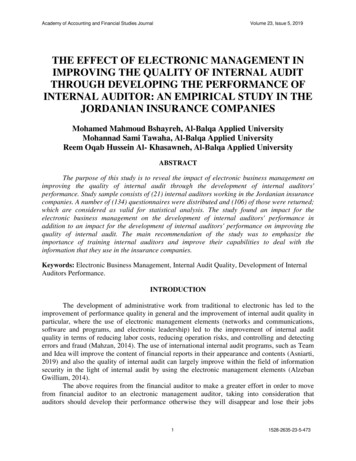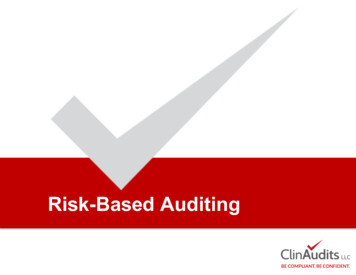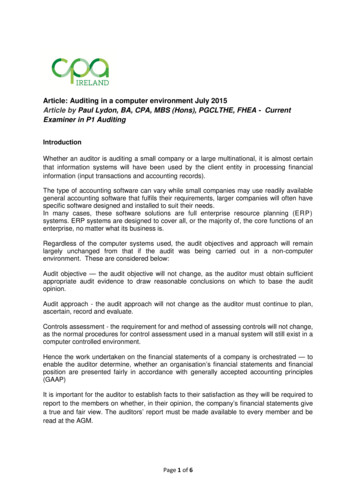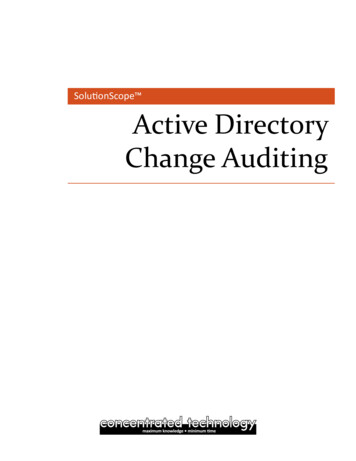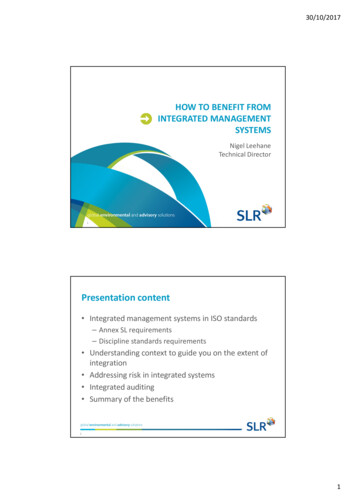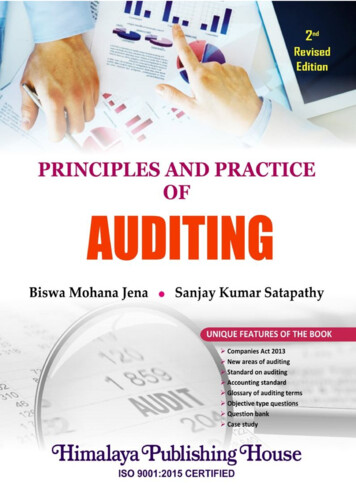
Transcription
PRINCIPLES AND PRACTICE OFAUDITINGDR. BISWA MOHANA JENADR. SANJAY KUMAR SATAPATHYHead, Department of Commerce & Economics,Netaji Subhas Chandra Bose Govt. Lead College,Sambhalpur, Odisha.Professor,School of Commerce & Management,Ravenshaw University,Cuttack, Odisha.ISO 9001:2015 CERTIFIED
AUTHORSNo part of this publication may be reproduced, stored in a retrieval system, or transmitted inany form or by any means, electronic, mechanical, photocopying, recording and/or otherwisewithout the prior written permission of the authors and the publisher.First Edition : 2012Second Revised Edition : 2019Published by:Branch Offices:Mrs. Meena Pandey for Himalaya Publishing House Pvt. Ltd.,Ramdoot, Dr. Bhalerao Marg, Girgaon, Mumbai - 400 004Phone: 022-23860170/23863863; Fax: 022-23877178E-mail: himpub@vsnl.com; Website: www.himpub.comNew Delhi:Pooja Apartments, 4-B, Murari Lal Street, Ansari Road, Darya Ganj,New Delhi - 110 002. Phone: 011-23270392, 23278631; Fax: Kundanlal Chandak Industrial Estate, Ghat Road, Nagpur - 440 018.Phone: 0712-2738731, 3296733; Telefax: 0712-2721216Plot No. 91-33, 2nd Main Road, Seshadripuram, Behind Nataraja Theatre,Bengaluru - 560 020. Phone: 080-41138821;Mobile: 09379847017, 09379847005No. 3-4-184, Lingampally, Besides Raghavendra Swamy Matham, Kachiguda,Hyderabad - 500 027. Phone: 040-27560041, 27550139New No. 48/2, Old No. 28/2, Ground Floor, Sarangapani Street, T. Nagar,Chennai-600 012. Mobile: 09380460419First Floor, Laksha Apartment, No. 527, Mehunpura, Shaniwarpeth(Near Prabhat Theatre), Pune - 411 030. Phone: 020-24496323, 24496333;Mobile: 09370579333House No. 731, Shekhupura Colony, Near B.D. Convent School, Aliganj,Lucknow - 226 022. Phone: 0522-4012353; Mobile: 09307501549114, SHAIL, 1st Floor, Opp. Madhu Sudan House, C.G. Road, Navrang Pura,Ahmedabad - 380 009. Phone: 079-26560126; Mobile: 0937708884739/176 (New No. 60/251), 1st Floor, Karikkamuri Road, Ernakulam,Kochi - 682011. Phone: 0484-2378012, 2378016; Mobile: 09387122121Plot No. 214/1342, Budheswari Colony, Behind Durga Mandap,Bhubaneswar - 751 006. Phone: 0674-2575129; Mobile: 09338746007108/4, Beliaghata Main Road, Near ID Hospital, Opp. SBI Bank, Kolkata - 700 010,Phone: 033-32449649; Mobile: 07439040301DTP byPrinted at::HPH, Editorial Office, Bhandup/SnehaGeetanjali Press Pvt. Ltd., Nagpur (S). On behalf of HPH.
PREFACE TO THE SECOND REVISED EDITIONThe development of modern accountancy and the growth of the auditing professionin India and, indeed, in the world as a whole must be seen in the context of the enormousexpansion of industry, trade and commerce which has taken place in the last decade. Theauditing profession is now going beyond the duties prescribed by the Companies Act.It is initiating its own accounting standards, and auditing regulations and guidelines.At present, it has sought to standardise the accounting procedure by issuing mandatoryaccounting standards and also issuing standardised auditing guidelines for conductingaudit work. In addition to that, auditing in its modern form has adopted a multidimensionalapproach. At present, the scope of auditing is not restricted to only financial audit underthe Companies Act but has been extended to cost accounts, managerial policies, operationalefficiencies, system applications, social implications of business organisations and environmentalaspects too.This book has made update on Companies Act, 2013, recent developments in auditingpractice and procedure, and changes in accounting and auditing standards. The aboveupdates will help the students to get latest challenges in the field of auditing. The aim ofthis book is to provide the students with sound ideas on the principles, methods andtechniques of solving auditing compliance together with ample scope for mastering thesubjects through practice. All the stress and strain we have encountered while writing thisbook will be considered meaningful and substantial if this title fulfills the expectations ofthe students.We take this opportunity to place on record our sincerest thanks to all our teachersand colleagues, friends, scholars and well-wishers who have been a perennial source ofinvaluable advice, thanks, co-operation and inspiration to us in our endeavour to preparethe manuscript of this book. We also thank Mr. Bijay Kumar Ojha, Himalaya PublishingHouse Pvt. Ltd., but for whose kind patronage, the book could not have been brought out.All suggestions for the improvement of the book received from any quarter would begratefully and gracefully acknowledged.sanjaya satapathy@yahoo.comDr. Sanjay Kumar Satapathyjenabiswamohan@gmail.comDr. Biswa Mohana Jena
CONTENTSPreface1.Introduction to Auditing1 – 262.Classification of Auditing27 – 433.General Conduct of an Audit44 – 564.Internal Control, Internal Check and Internal Audit57 – 775.Vouching of Cash Transactions78 – 926.Vouching of Trading Transactions93 – 997.Vouching of Impersonal Transactions100 – 1078.Verification of Liabilities108 – 1139.Verification of Assets114 – 12810.Verification of Financial Statements and Balance Sheet129 – 13811.Reserves and Provisions139 – 14812.Company Accounts149 – 16713.Audit Report168 – 18614.Dividend and Divisible Profit187 – 19815.Audit of Debentures199 – 20216.Audit in EDP Environment203 – 21017.Investigation211 – 22218.Liabilities of an Auditor223 – 23019.Special Audits231 – 24920.New Areas of Auditing250 – 273Objective Type Questions with Answers274 – 279Annexures280 – 284Glossary of Auditing Terms285 – 288Significant Legal Decisions289 – 291Companies Act, 2013292 – 306
1INTRODUCTION TO AUDITINGLearning Objectives:Going through the chapter carefully, we could:Understand the concept, fundamentals postulates and major objectives of audit.Be familiar with the auditing practices when there is a possible evidence of fraud. Be aware of the auditor’s responsibility in this regard. 1.0 EVOLUTIONThe word “Auditing” has been derived from the Latin word “Audire”, which means“to hear”. Such an expression conveys the foundation of auditing in ancient days. However,in the post-ancient period, auditing has gone through dramatic changes. According toDicksee, traditional auditing can be understood as an examination of accounting recordsundertaken with a view to establishing whether they completely reflect the transactioncorrectly for the related purpose. But this is not the end of the story. Besides, the auditoralso expresses his opinion on the financial character of the statements of accounts preparedfrom the accounting records, so as to examine whether they portray the true and fair viewof financial statements. The term audit is used in this sense ever since the days when publicaccounts were accepted and approved on the basis of leaving the accounts read. It wasFra Luca Bartolomeo de Pacioli (popularly known as Luca Pacioli), father of accountingwho introduced double entry bookkeeping. He defined and described the duties andresponsibilities of an auditor. Since then, there have been far-reaching changes in thescope and definition of audit. Further, the industrial revolution in England compelled thenecessity of auditing. When the First Companies Act of 1913 came into force, it becameobligatory on the part of every company registered under it, to have the accounts auditedat least in every year.1
2PRINCIPLES AND PRACTICE OF AUDITING1.1 CONCEPT OF AUDITINGConcept of Auditing dates back to ancient Egyptian, Roman and Greek Civilizations,where commercial transactions were systematically checked and counterchecked by financialadministrators. In India, Pre-Vedic literature makes references to the existence of welldeveloped system of accountancy. In ancient times, auditing was coupled with the levy oftax. Whenever taxes were levied on commercial transactions, auditing became inevitable.When a person was appointed to administer finance, the amount received and paymentsmade by him were checked by another official either periodically or at the time of expiryof his term of office. The objectives, techniques and approaches of today’s audit areentirely different from that of the past. One can say that the change in the technology,expansion of business organization, diversification of activities have influenced and alteredthe auditing scope and techniques. Present-day Auditing has come a long way fromtraditional auditing. Traditional auditing involved vouching of all transactions, verificationof posting to ledgers, detailed verification of documents, subsidiary books and the principalbooks of entries. This was possible because the business entities were small, the transactionswere not many, the activities were localized and traditional method of bookkeeping wasfollowed.In the contemporary world, business organizations have expanded and diversifiedtheir activities. The transactions have become numerous. The fast developing communicationtechnology has shrunk the earth into a global village. Transactions are made throughinternet across the world. Rates are fixed over telephone. Receipts and payments are madeonline. Use of paperwork has been reduced greatly. In these circumstances, it is impossibleto apply the traditional methods of GENCEI:INSPECTIONT:TRANSPARENCY1.2 WHAT IS AN AUDIT?An audit is the examination of the financial report of an organization - as presentedin the annual report – by someone independent of the organization. The financial reportincludes a balance sheet, an income statement, a statement of changes in equity, a cashflow statement, and notes comprising a summary of significant accounting policies andother explanatory notes.The purpose of an audit is to form a view on whether the information presented inthe financial report, taken as a whole, reflects the financial position of the organization ata given date, for example: Are details of what is owned and what the organization owes properly recordedin the balance sheet? Are profits or losses properly assessed?
INTRODUCTION TO AUDITING3When examining the financial report, auditors must follow auditing standards whichare set by a government body. Once auditors have completed their work, they write anaudit report, explaining what they have done and giving an opinion drawn from their work.With some exceptions, all organisations subject to the Corporations Act must have an auditeach year. Other organizations may require or request an audit depending on their structureand ownership or for a special purpose.What Don’t Auditors Do? Audit other information provided to the members of the organization, for example,the directors’ report.Check every figure in the financial report – audits are based on selective testingonly.Judge the appropriateness of the organisation’s business activities or strategies ordecisions made by the directors.Look at every transaction carried out by the organization.Test the adequacy of all of the organisation’s internal controls.Comment to shareholders on the quality of directors and management, the qualityof corporate governance or the quality of the organization’s risk managementprocedures and controls.What Can’t Auditors Do?Predict the future – The audit relates to a specific past accounting period. It doesnot judge what may happen in the future, and so cannot provide assurance thatthe organisation will continue in business indefinitely. Be there all the time – The audit is carried out during a defined time frame, andauditors are not at the organization all the time. The prime purpose of the auditis to form an opinion on the information in the financial report taken as a whole,and not to identify all possible irregularities. This means that although auditors areon the look-out for signs of potential material fraud and it is not possible to becertain that frauds will be identified. How is the Audit Conducted? The organization’s management prepares the financial report. It must be preparedin accordance with legal requirements and financial reporting standards.The organisation’s directors approve the financial report.Auditors start their examination by gaining an understanding of the organization’sactivities, and considering the economic and industry issues that might have affectedthe business during the reporting period.For each major activity listed in the financial report, auditors identify and assessany risks which could have a significant impact on the financial position or financialperformance, and also some of the measures (called internal controls) that theorganisation has put in place to mitigate those risks.Based on the risks and controls identified, auditors consider what managementhas done to ensure the financial report is accurate, and examine supportingevidence.
4PRINCIPLES AND PRACTICE OF AUDITINGAuditors then make a judgment as to whether the financial report taken as awhole presents a true and fair view of the financial results and position of theorganization, its cash flows, is in compliance with financial reporting standardsand, if applicable, the Corporations Act. Finally, auditors prepare an audit report setting out their opinion, for the organization’sshareholders or members. What Do Auditors Do, Specifically?Auditors discuss the scope of the audit work with the organisation – the directors ormanagement may request that additional procedures be performed. Auditors maintainindependence from management and directors so that tests and judgments are madeobjectively. Auditors determine the type and extent of the audit procedures they will perform,depending on the risks and controls they have identified. The procedures may include: Asking a range of questions – from formal written questions, to informal oralquestions – of a range of individuals at the organization. Examining financial and accounting records, other documents, and tangible itemssuch as plant and equipment. Making judgments on significant estimates or assumptions that management madewhen they prepared the financial report. Obtaining written confirmations of certain matters, for e.g., asking a debtor toconfirm the amount of their debt with the organisation. Testing some of the organisation’s internal controls. Watching certain processes or procedures being performed.1.3 MEANING OF AUDITINGAn examination and verification of a company’s financial and accounting records andsupporting documents by a professional, such as a certified chartered Accountant. Auditingis the systematic and scientific examination of the books of accounts and records of abusiness. It enables the auditors to judge that the Balance Sheet and the Profit and LossAccount are properly drawn up so it exhibits a true and fair view of the financial state ofaffairs of the business and profit or loss for the financial period.1.4 DEFINITIONS OF AUDITINGAuditing is concerned with the verification of accounting data, with determining theaccuracy and reliability of accounting statements and reports.— R.R. MoutzAuditing is an intelligent and a critical scrutiny of the books of accounts of a businesswith the documents and vouchers from which they are written up, for the purpose ofascertaining whether the working results for a particular period, as shown by the profit andloss account, also the exact financial condition of the business, as reflected in the balancesheet are truly determined and presented by those responsible for their compilation.— J.R. Batliboi“An audit denotes the examination of balance sheet and profit and loss accountprepared by others together with the books of accounts and vouchers relating thereto in
INTRODUCTION TO AUDITING5such a manner that the auditor may be able to satisfy himself and honestly report that, inhis opinion, such balance sheet is properly drawn up so as to exhibit a true and correctview of the state of affairs of the particular concern according to the information andexplanations given to him and as shown by the books”.— F.R.M. De PaulaAuditing is a systematic examination of books and records of a business of otherorganization in order to ascertain or verify and to report upon the facts regarding thefinancial operations and the results thereof.— MontgomeryAn audit is an exploratory, critical review by a public accountant of the underlyinginternal controls and accounting records of a business enterprise or other economic unit,precedent to the expression by him of an opinion of the propriety of its financial statements.— Eric L. KohlerAuditing may be defined as “inspecting, comparing, checking, reviewing, vouching,ascertaining, scrutinizing, examining and verifying the books of accounts of a businessconcern with a view to have a correct and true idea of its financial state of affairs.”— M.L. ShandilyaAccording to the INSTITUTE OF CHARTERED ACCOUNTANTS OF INDIA, “generalguidelines in internal auditing defines auditing as the independent examination of financialinformation of any entity, whether profit oriented or not, and irrespective of its size or legalform, when such examination is conducted with a view to expressing an opinion thereon.”“In brief, auditing involves testing the reliability, competency and adequacy of evidencein support of monetary transactions. It has its principal roots in accounting with it’sreviews, on which it leans heavily for idea and methods.S.K. SATAPATHY & B.M. JENA — “Auditing signifies the spiraling functions ofauditors who certify the true and fair view of financial statements by delvingthrough the process of checking, vouching and verification with its operationalefficiency, economy and effectiveness.”AAS-1 defines the audit and also set out the basic principles, which govern the auditor’sresponsibilities in carrying out the audit.As per AAS-1, “An audit is the independent examination of financial information of anentity whether profit oriented or not and irrespective of size or legal form when suchexamination is conducted with a view to express opinion thereon”.Auditing is a systematic process of objectively obtaining and evaluating evidenceregarding assertions about economic actions and events to ascertain the degree of correspondencebetween those assertions and established criteria and communicating the results to interestedusers. Auditing is the analysis of the financial accounts/records, by a qualified accountant,and procedures of a firm or organization. This is essential in order to gain a fair perspectiveon the company’s financial statements. With auditing, potential investors and creditors canlook at the financial statements to decide whether to invest in a business or not. Auditingis important as it also protects the public from scams and corrupt business procedures.
6PRINCIPLES AND PRACTICE OF AUDITING1.5 AUDITING – THE NEED AND IMPORTANCE OF AUDITING IN ABUSINESS ORGANIZATIONThe word ‘audit’, has been derived from the Latin word “Audire” meaning to hear.Auditing is a formal examination of accounting books, documents and vouchers of abusiness concern in order to verify the profit and loss and the financial position of abusiness. It is a systematic check or assessment of financial records of a business, departmentor organization to establish accuracy or efficiency or effectiveness.The need of audit arises due to the fact that a business enterprise needs to ensurethe correctness of all accounts pertaining to the business. It is also important to ascertainwhether or not, the financial statements, profit and loss account and balance sheet havebeen prepared in a way as to show the summary of the flow of transactions for the wholeperiod and the true picture and position of a business enterprise. Besides, in order toensure the accuracy or the efficiency of the records, detection and prevention of errors isvitally important. Hence, audit under its main objectives and subsidiary objectives fulfills thepurpose.Audit is an effective tool for Business Management, as internal audit is conducted inorder to ensure the policies are being followed. It enables to make valuable suggestionsfor improvement and to formulate future policies of a business. Audit also helps managementto review the policies from time to time.Since audit involves a detailed verification of accounting records: It helps greatly todiscover errors or frauds while it promotes a moral check on the employees through whichtheir efficiency may also be determined. To its more positive form, audit can motivate theemployee to maintain the efficiency leading to increase their performance level. Aside fromthese, it is with the help of audit that misappropriation of goods and manipulation ofrecords may be identified.Audit is of great importance to gain confidence in investors of a joint stock company.Since the audited statements are very much useful, the investors can ensure whether ornot they need to invest capital.1.6 DIFFERENCES BETWEEN1.6.1 Accountancy and BookkeepingAccountancy involves recording of all transactions having financial character andclassifying, summarizing and interpreting the activities of the organization for a particularperiod by preparing profit and loss account and balance sheet.Bookkeeping is the initial part of accounting involving recording of all transactions,journalizing, posting and balancing. The errors are rectified and the balances are arrivedat by the accountant. The profit earned or loss incurred for a particular period is arrivedby the preparation of Profit and Loss Account. The financial status of the organization ason a particular date is shown in the balance sheet.
INTRODUCTION TO AUDITING71.6.2 Bookkeeping and Auditing PostingBookkeepingAuditing(i) Bookkeeping involves recording oftransactions in the books of accounts.(i) Auditing involves examination of BalanceSheet and Profit & Loss account, whichare prepared from Trial Balance in orderto find out whether they are preparedin conformity with law and shows thetrue and fair view of business concerns.(ii) There is no need for skill, knowledge,etc. for bookkeeping.(ii) In case of auditing, skill, knowledge,etc. are must.(iii) Nature of work is more or less ofmechanical or routine.(iii) In auditing, work is technical in nature.(iv) Bookkeeping is continuous process anddone throughout the year.(iv) Generally, auditing is carried on till thecompletion of the year.(v) Bookkeepers are regular and paidemployees.(v) Auditors not regular and are not paidemployees.(vi) The work of bookkeeping preceedsauditing.(vi) The work of auditing starts where thebookkeeping ends.(vii) Bookkeeping work is constructive inapproach.(vii) Audit work is critical and nanlytical inapproach.(viii) Bookkeeping relates to the currentperiod.(viii) Auditing is done for the previous year.
8PRINCIPLES AND PRACTICE OF AUDITING1.6.3 Accountancy and AuditingAccountancyAuditing(i) Accountancy is primarily constructivein nature and it is concerned withcompilation of accounting informationpreparing Profit & Loss Account andBalance Sheet.(i) Auditing is analytical in nature and isconcerned with checking andverification of financial statements.(ii) It involves preparation of financialstatements and their interpretation.(ii) It involves examination and checkingof accounting records.(iii) The object of Accountancy is to findout the operating results and financialposition of the business concern.(iii) The object of auditing is to ascertainthe truth and fairness of the financialstatements and to comment on it.(iv) No formal qualification has beenprescribed for an accountant.(iv) An auditor must necessarily be aChartered Accountant.(v) Accountancy starts where bookkeepingends.(v) Auditing starts where Accountancy ends.(vi) An accountant need not be an expertin the work of auditing.(vi) An auditor must be an expert both inaccounting as well as auditing.(vii) Accountant is a permanent employeeof a concern.(vii) Auditor is an independent outsider.(viii) Accounting work isthroughout the year.carriedon(ix) Accountant receives monthly salary.(x) Accountant need not prepare and submita report on the accounts and statementsprepared by him.(viii) Auditing is carried on generally at theend of the financial year.(ix) Auditor gets a fixed sum as per theagreement.(x) Auditor is required to prepare andsubmit a report about the truthfulnessand fairness of accounts audited byhim.
INTRODUCTION TO AUDITING91.6.4 Audit and Investigation AuditAuditInvestigation(i) Audit is the scientific and systematicexamination of the books, accounts,vouchers, and other financial recordsthat will help an auditor to give opinionregarding true and fair view of the stateof affairs of the business and Profit &Loss accounts.(i) Investigation is a process through whichan investigator on behalf of his clientinvestigates different matters as per needof the client and gives report to him.(ii) Audit is compulsory in case of companyas per Companies Act 1956.(ii) Investigation is not compulsory and isconducted as per the needs of client(except special audit made by the orderof the Government as per statute).(iii) A person must be a Chartered Accountantfor conducting statutory audit of acompany.(iii) There is no prescribed qualification inthe Companies Act for conductinginvestigation (except special audit directedby the Government).(iv) Audit techniques such as test checkingcan be applied for vouching andverification of books of accounts.(iv) Detailed examination of books ofaccounts is required to solve the specialpurpose.(v) Remuneration of a company auditor isdetermined as per Companies Act.(v) Remuneration is fixed by agreementbetween the client and the investigator.(vi) Audit is mainly concerned with theexamination of the books of accounts.(vi) It includes examination of financial,technical, legal, economic, social, etc.(vii) The time of completing audit work isgenerally required for four to six months.(vii) The time of completing investigationwork may require several years.(viii) The report of the auditor is prepared (viii) In case of investigation, report may belong enough to present the details ofas per Companies Act and the auditor’sinvestigation, i.e., financial, technical,opinion and not too long.legal and other aspects.(ix) The company auditor will place his reportto the shareholders of the company.(ix) The report of investigator is to besubmitted to the Appointing Authority.(x) Audit is the examination of books ofaccounts which remains unexaminedbefore that.(x) Where the auditing work ends, the workof investigation starts, i.e., investigationis the special type of examination ofaudited accounts.
10PRINCIPLES AND PRACTICE OF AUDITING(xi) Audit is conducted on behalf of theowner of the entity.(xi) Investigation may be conducted eitheron behalf of the owner or on behalfof outside parties.(xii) In case of audit work of a company,the work of an auditor cannot beavoided which is given in theCompanies Act, 1956, i.e., an auditormust not be negligent about his dutiesgiven in the Statute.(xii) In case of investigation, some mattersare left unchecked for examinationbecause investigation serves a specificpurpose and as per the needs of theclient.1.7 OBJECTS OF AUDITINGThe main object of auditing is to verify the accounts and to report whether theBalance Sheet and Profit and Loss account have been prepared as per the Companies Actand whether they show true and fair view of the state of affairs of the concern. Besides,there are certain subsidiary objects also to conduct an audit. They are as follows:(A) Detection and prevention of errors.(B) Detection and prevention of frauds.The various objects of an audit as shown in Fig. 1.1 are detailed in next page.1.7.1 Primary ObjectsThere are two objectives, which are considered as chief objectives of auditing. Theyare as below:(i) To see whether the financial statements are prepared in conformity with law:Business concerns prepare Balance Sheet to portray their financial position. They alsoprepare Profit and Loss account to disclose the operating results of the period covered inthe statement. These statements are submitted to the Auditor for checking and commenting.He checks the accounts with utmost diligence and care and also with professional competence.He verifies the accounts as to whether they are prepared as per the recognized accountingpolicies and practices, and also in conformity with the relevant statute.(ii) To see whether the financial statements reveal the true and fair view of thestate of affairs of the business concern: Auditor checks the financial statements submittedto him as to whether the facts given in Balance Sheet and Profit & Loss Account are truebased on the checking the forms and independent judgment and opinion about the reliabilityof the accounting records and true and fair view of financial state of affairs and workingresults.
INTRODUCTION TO AUDITING111.7.2 Secondary ObjectsThe secondary objectives as depicted in Fig. 1.1 are detailed hereunder.OBJECTIVES OF AUDITPrimary ObjectivesConfirmity withLawEmbezzlementof CashSecondary ObjectivesTrue and Fair Viewof State of Affairsof BusinessDetection andPreventionof FraudsMisappropriation Manipulationof Goodsof AccountsClericalErrorsErrors ofOmissionCompleteOmissionDetection andPreventionof ErrorsError ofPr incipleCompensatingErrorsErrors ofDuplicationErrors ofCommissionParti alOmissionFig. 1.1: Objectives of AuditA. Detection and Prevention of ErrorsGenerally, errors arise out of the innocence or carelessness on the part of thoseresponsible for the preparation of accounts. Sometimes, errors may be the outcome offraudulent manipulation of accounts. Therefore, the auditor must pay particular attentionto every error. The following are the various types of errors:(a) Clerical ErrorsClerical errors are those that are committed in posting, totaling and balancing. Sucherrors may again be subdivided into two namely.(i) Errors of Omission: The errors of omission arise when a transaction is whol
This book has made update on Companies Act, 2013, recent developments in auditing practice and procedure, and changes in accounting and auditing standards. The above updates will help the students to get latest challenges in the field of auditing. The aim of this book is to provide the
